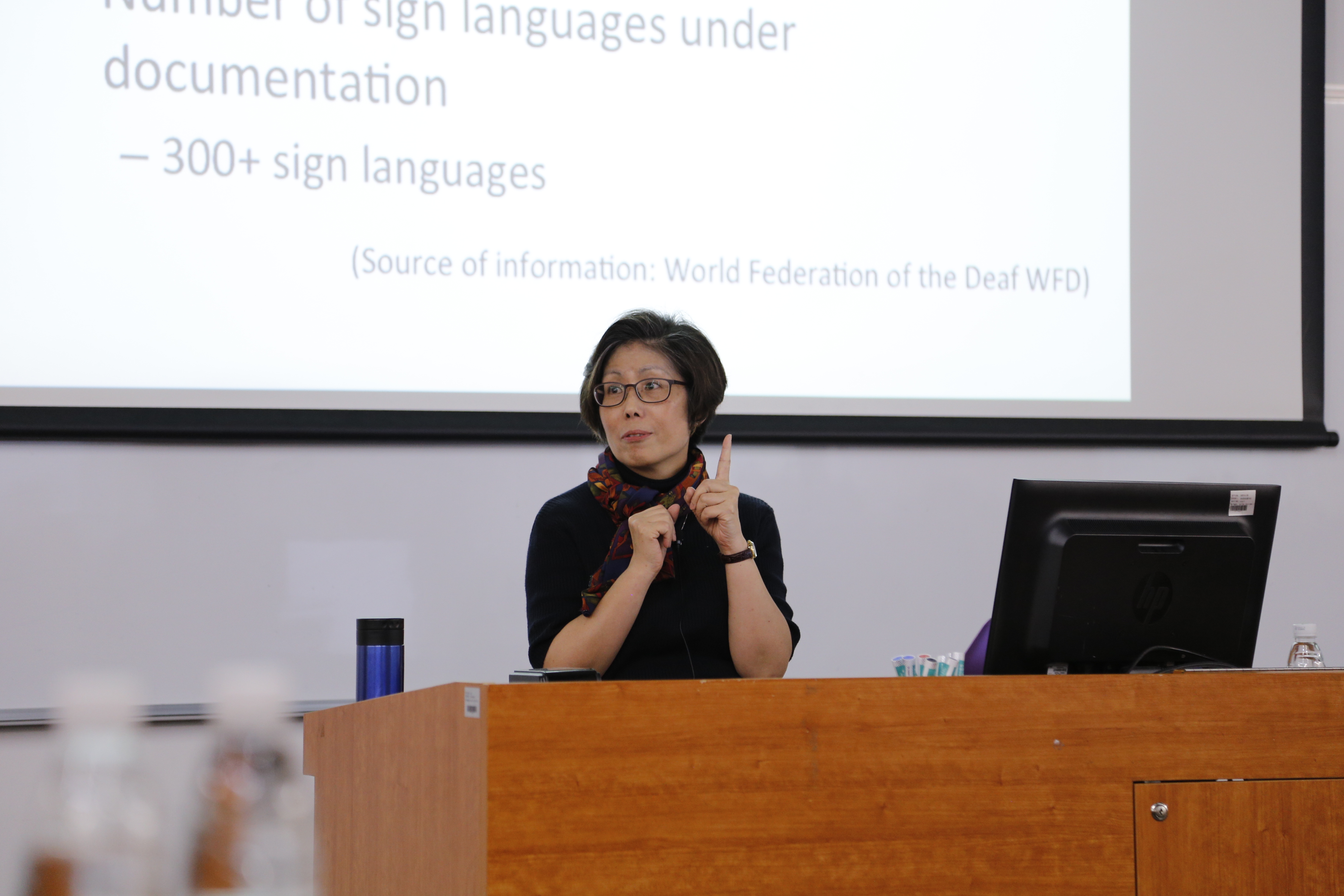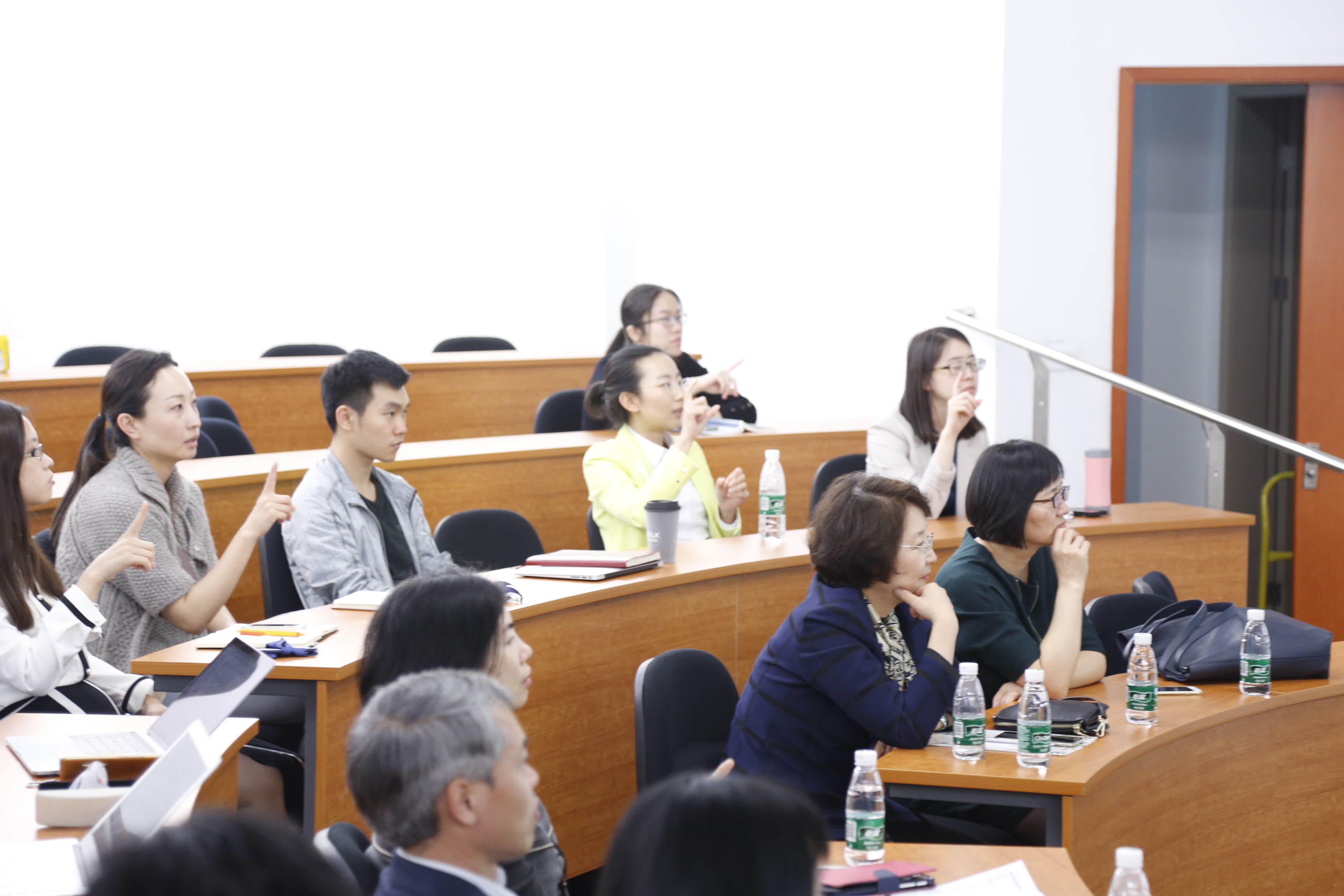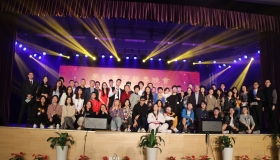Diligentia et Sapientia | Entering the Deaf World through Sign Language
On 14th April, school of Humanities and Social Science and Diligentia College invited Prof.TANG Wai-lan, director of Centre for Sign Linguistics and Deaf Studies, the Chinese University of Hong Kong, to unveil the ignored and misunderstood problems in the silent world for us.
Gloomy Situation
Prof. TANG began with statistics demonstrating an imbalance circumstance: according to data from the World Health Organization (WHO) and the World Federation of the Deaf (WFD), there are 70m people use sign language among 3600m hearing impaired person, which implied our imperceptive to the living condition of those people and misunderstanding about sign language. These issues have direct impacts on the language acquisition of deaf, even hinder their opportunity accessing to higher education. As it illustrated in distribution map, 80% hearing impaired person living in developing countries. Prof. TANG said in these countries, governments do not pay much attention and concern those people because the shortage of armamentarium and drug.

Public Image: Misconception
Prof.TANG told us high technologies like hearing aid, cochlear implant and auditory brainstem implant cannot help them to obtain the hearing ability as normal. Lip reading also helpless, due to most pronunciations cannot recognize through the shape of the lip. Besides, deafness is not equal to incapacitation of speaking, experimental results showed that deaf children could develop their language competence sufficiently that then benefit to spoken language learning, if they accessed to sign language in a critical period. However, there are parents of deaf children who are hearing people and not capable of sign language, for those children, they can neither learn the spoken language as hearing children nor can they learn the sign language at home. Therefore, promoting sign language among hearing impaired person, deaf children’s parents even hearing people could build an important channel of communication in the “silent world”.

Science Knowledge about Sign Language
With simple gestures, Prof.TANG Wai-lan showed us that sign language, as a natural language, has its own grammar and linguistic units, including facial expressions, body language and gestures. We could find common expressions in sign language and spoken language such as the quantifier expression used in Hong Kong.

Meaningful Task
Through sign language research and promotion, Prof. TANG helps the deaf to integrate into society and fulfill their development, encouraging hearing people embrace the silent world with inclusiveness and appreciation. She not only promote sign language in schools for the deaf, which could develop these children’s linguistic ability and self-identity then accepted by the society but also launched the “Sign Bilingualism and Co-enrolment in Deaf Education Programme” helping these students study in mainstream schools and access to the same education opportunity as normal. Under this education model, deaf students could both make process in the academic field and facilitate their social ability. Now, this model has been popularized around the world, sharing the benefits of sign language research among deaf people, making sign language the bridge linking hearing and hearing impaired person.

Comments
As a visual language, we could not only use sign language to communicate, but it is also of great importance to education and culture communication. I am touched by the project led by Prof. TANG Wai-lan, that literally leading the deaf children’s education out of the dark ages. --Staff, Maxine
I used thought sign language is a simplified communication signal, after the lecture I understand it is not just a series of gestures but a body language, including hand gestures and facial expressions, with its own grammar and unique language system. It can help the deaf to communicate freely and hearing people also could learn it as a minority language. If we could propel the usage of sign language in study system, maybe we could understand the deaf better. There are so many uncertain things, but undoubtedly, the project led by Prof. TANG Wai-lan is an important one. --Staff, Qin
I am delighted to have this opportunity took part in the lecture given by Prof. Gladys Tang. Before the lecture, I was moved by a video named “CU50•The People” Gladys Tang, in which the deaf children became more confidence and happier in learning sign language with tutors’ help, they could even singing and using sign language the same time. As a “normal”, we might never attempt to understand the world of the deaf, their helplessness, eagerness to be understood and express themselves, the gratitude they may felt when those hopes came true and are cared. Prof. Tang eliminated these misunderstandings about sign language and introduced the prosperity of this project: hearing children learn sign language with hearing impaired children. This academic research is of great practical significance, it also changing countless lives of deaf children. They have the capability and right to learn as normal children. Language is an obstacle while sign language opened a door to another world. Luckily, there are many scholars devoted themselves to the research and promotion of sign language just as Prof. Tang, helping people regain the hope for life. It is a great mission. After this lecture, I hope there will be more people pay attention to this group and take actions. --Staff, Amanda
This lecture gave me an insight about sign language and wisdom of deaf. They should share the same right to obtain a higher education as us, not just limited to the specialized school for the deaf. Prof. TANG Wai-lan showed her enthusiasm and passion for promoting sign language. With the hard works done by them, I hope more countries would join sign language projects and eliminate the misconception about the deaf. --Gao Haiqing, freshmen from SSE
What does the silent world look like? Before this lecture, I thought the deaf is a small proportion in our society, and they could live as normal with the help of hearing-aid and other medical operation. While it is far from the truth. They account for 5% of the world’s population, and no matter how advanced the technology is, it cannot help them to communicate with spoken language now. While as a unique language, sign language could change deaf people’s life. Just as Prof. TANG said, hearing impaired is not a defect, but another way of life with another minority language. It will be better if everyone learns sign language than compelling the deaf to speak. --Zhou Zihua, freshmen from HSS
There are splendid hearing world and a wonderful silent world. As a hearing person, the most important thing is not about how much help we could give to the hearing impaired person, but whether we could interact with them equally, to take care them. When you met someone in need, do not put on blinkers and turn your back to them, just be patient and “listen” to them. --Xie Wutong, sophomore from SSE
I just understand there are so many deaf children in China while little projects to help them in this lecture. These children need to communicate and develop even living in the silent world, while sign language could help. It is not just designed for hearing impaired person, but everyone could use it to communicate with deaf-mute, we should not hold prejudice against sign language. It is a meaningful project, which could lead deaf children to live a happier life. Hope the project will thrive! ---Zhou Hailin, freshman from HSS




